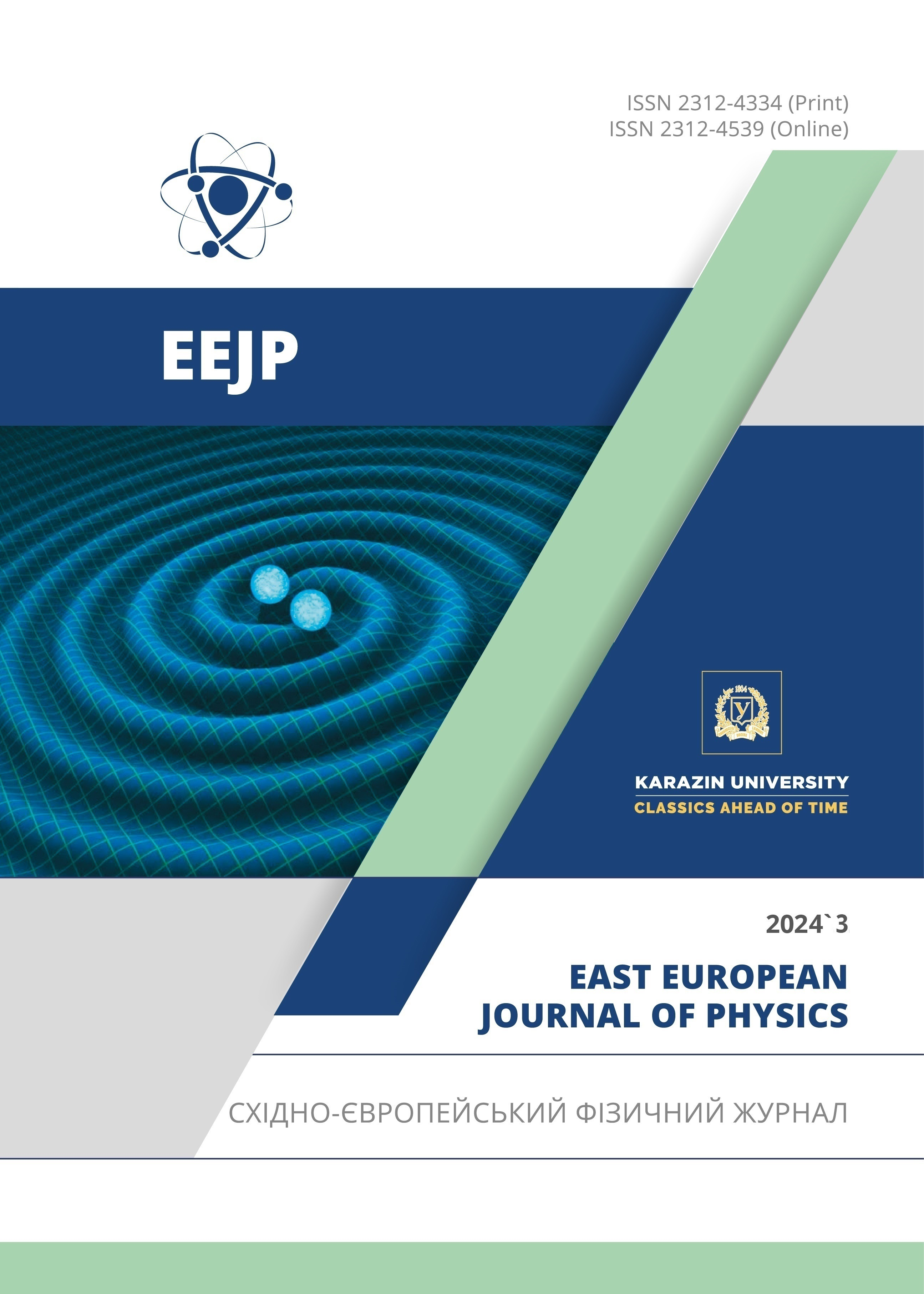Cosmic Evolution in a Bianchi type-V Universe with Barrow Holographic Dark Energy with Granda-Oliveros Length Scale as IR Cutoff
Abstract
In this work, we construct a spatially homogeneous and anisotropic Bianchi type-V cosmological model with a hybrid expansion law by considering the universe to be filled with cold dark matter and non-interacting Barrow holographic dark energy with Granda-Oliveros length scale as IR cutoff. The physical and kinematical characteristics of the resulting model are discussed by studying the evolution of various parameters of cosmological importance such as the Hubble parameter, the deceleration parameter, the anisotropic parameter, the equation of state parameter, jerk parameter etc. We also examine whether the energy conditions are satisfied or violated. Our analysis reveals that the Null,Weak, and Dominant energy conditions are fullfilled, while the Strong Energy Condition is violated, which supports the accelerated expansion of the universe. Statefinder diagnostics have also been performed based on recent cosmological observations in order to compare our model with different dark energy cosmological scenario. Additionally, we establish the correspondence between the quintessence scalar field and the Barrow holographic dark energy model, supporting our description of the universe’s accelerated expansion.
Downloads
References
A.G. Riess, et al., "Observational evidence from supernovae for an accelerating universe and a cosmological constant," The Astronomical Journal, 116, 1009-1038 (1998). https://doi.org/10.1086/300499
S. Perlmutter, et al., "Measurements of Ω and Λ from 42 high-redshift supernovae," The Astrophysical Journal, 517, 565-586 (1999). https://doi.org/10.1086/307221
D.N. Spergel, et al., "Frist-year Wilkinson Microwave Anisotropy Probe (WMAP) observations: Determination of cosmological parameters," Astrophys. J. Suppl. Ser. 148, 175–194 (2003). https://doi.org/10.1086/377226
D.N. Spergel, et al., "Three-Year Wilkinson Microwave Anisotropy Probe (WMAP) Observations: Implications for Cosmology," Astrophys. J. Suppl. Ser. 170, 377 (2007). https://doi.org/10.1086/513700
E. Komatsu , et al., "Five-Year Wilkinson Microwave Anisotropy Probe observation: cosmological interpretation," Astrophys. J. Suppl. Ser. 180, 330 (2009). https://doi.org/10.1088/0067-0049/180/2/330
M. Tegmark, et al., "Cosmological parameters from SDSS and WMAP," Phys. Rev. D, 69, 103501 (2004). https://doi.org/10.1103/PhysRevD.69.103501
U. Seljak, et al., "Cosmological parameter analysis including SDSS Lyα forest and galaxy bias: constraints on the primordial spectrum of fluctuations, neutrino mass, and dark energy," Phys. Rev. D, 71, 103515 (2005). https://doi.org/10.1103/PhysRevD.71.103515
M. Tegmark, et al., "Cosmological constraints from the SDSS luminous red galaxies," Phys. Rev. D, 74, 123507 (2006). https://doi.org/10.1103/PhysRevD.74.123507
D.J. Eisenstein, et al., "Detection of the Baryon Acoustic Peak in the Large-Scale correlation function of SDSS luminous red galaxies," The Astronomical Journal, 633, 560-574 (2005). https://doi.org/10.1086/466512
P.J.E Peebles and Bharat Ratra, "The cosmological constant and dark energy," Rev. Mod. Phys. 75, 559 (2003). https://doi.org/10.1103/RevModPhys.75.559
Planck Collaboration, "Planck 2018 results VI. Cosmological parameters," A&A, 641, A6 (2020). https://doi.org/10.1051/0004-6361/201833910
Edmund J.Copeland, "Dynamics of Dark Energy," AIP Conf. Proc. 957, 21–29 (2007). https://doi.org/10.1063/1.2823765
G.’t Hooft, "Dimensional reduction in quantum gravity," arXiv.gr-qc/9310026 (2009). https://doi.org/10.48550/arXiv.gr-qc/9310026
A.G. Cohen, D.B. Kaplan, and A.E. Nelson, "Effective Field Theory, Black Holes, and the Cosmological Constant," Phys. Rev. Lett. 82, 4971-4974 (1999). https://doi.org/10.1103/PhysRevLett.82.4971
P. Hořava, and D. Minic, "Probable Values of the Cosmological Constant in a Holographic Theory," Phys. Rev. Lett. 85, 1610-1613 (2000). https://doi.org/10.1103/PhysRevLett.85.1610
S.D.H. Hsu, "Entropy bounds and dark energy," Phys. Lett. B, 594, 13 (2004). https://doi.org/10.1016/j.physletb.2004.05.020
M. Li, ”A model of holographic dark energy,” Phys. Lett. B, 603, 1-5 (2004). https://doi.org/10.1016/j.physletb.2004.10.014
L.N. Granda, and A. Oliveros, "Infrared cut-off proposal for the holographic density," Phys. Lett. B, 669(5), 275-277 (2008). https://doi.org/10.1016/j.physletb.2008.10.017
M. Tavayef, A. Sheykhi, K. Bamba, and H. Moradpour, "Tsallis holographic dark energy," Phys. Lett. B, 781, 195–200 (2018). https://doi.org/10.1016/j.physletb.2018.04.001
C. Tsallis, and L.J.L. Cirto, "Black hole thermodynamical entropy," Eur. Phys. J. C, 73, 2487 (2013). https://doi.org/10.1140/epjc/s10052-013-2487-6
H. Moradpour, et al.: "Thermodynamic approach to holographic dark energy and the Rényi entropy," Eur. Phys. J. C, 78, 829 (2018). https://doi.org/10.1140/epjc/s10052-018-6309-8
J.D. Barrow, "The area of a rough black hole," Phys. Lett. B, 808, 135643 (2020). https://doi.org/10.1016/j.physletb.2020.135643
S. Wang, Y. Wang, and M. Li, "Holographic dark energy," Phys. Rep. 696, 1–57 (2017). https://doi.org/10.1016/j.physrep.2017.06.003
E.N. Saridakis, "Barrow holographic dark energy," Phys. Rev. D, 102, 123525 (2020). https://doi.org/10.1103/PhysRevD.102.123525
S. Srivastava, and U.K. Sharma, "Barrow holographic dark energy with Hubble horizon as IR cutoff," Int. J. Geo. Methods in Mod. Phys. 18, 2150014 (2021). https://doi.org/10.1142/S0219887821500146
N. K. P and T. K. Mathew, "Barrow Holographic Dark Energy Model with GO Cut-off – An Alternative Perspective," https://doi.org/10.48550/arXiv.2112.07310
A. Oliverosa , M.A. Sabogalb, M.A. Acero, "Barrow holographic dark energy with Granda–Oliveros cutoff," Eur. Phys. J. Plus, 137, 783 (2022). https://doi.org/10.1140/epjp/s13360-022-02994-z
B.C. Paul, et al., "Bianchi-I anisotropic universe with Barrow holographic dark energy," Eur. Phys. J. C, 82, 76 (2022). https://doi.org/10.1140/epjc/s10052-022-10041-5
C.L. Bennett et al., "The Microwave Anisotropy Probe* Mission," The Astrophysical Journal, 583, 1-23 (2003). https://doi.org/10.1086/345346
Bernardis, et al., "MAXIMA-1: A Measurement of the Cosmic Microwave Background Anisotropy on Angular Scales of 10’-5°," The Astrophysical Journal, 545, (2000). https://doi.org/10.1086/317322
G. Hinshaw et al., "Fıve-Year Wılkınson Mıcrowave Anısotropy Probe* Observatıons: Data Processıng, Sky Maps, and Basıc Results," The Astrophysical Journal Supplement Series, 180, 225–245 (2009). https://doi.org/10.1088/0067-0049/180/2/225
V. Sahni, T.D. Saini, A.A. Starobinsky, and U. Alam, "Statefinder—a new geometrical diagnostic of dark energy," JETP Lett. 77, 201-206 (2003). https://doi.org/10.1134/1.1574831
Copyright (c) 2024 Chandra Rekha Mahanta, Rajashree Mahanta, Joy Prakash Medhi

This work is licensed under a Creative Commons Attribution 4.0 International License.
Authors who publish with this journal agree to the following terms:
- Authors retain copyright and grant the journal right of first publication with the work simultaneously licensed under a Creative Commons Attribution License that allows others to share the work with an acknowledgment of the work's authorship and initial publication in this journal.
- Authors are able to enter into separate, additional contractual arrangements for the non-exclusive distribution of the journal's published version of the work (e.g., post it to an institutional repository or publish it in a book), with an acknowledgment of its initial publication in this journal.
- Authors are permitted and encouraged to post their work online (e.g., in institutional repositories or on their website) prior to and during the submission process, as it can lead to productive exchanges, as well as earlier and greater citation of published work (See The Effect of Open Access).








